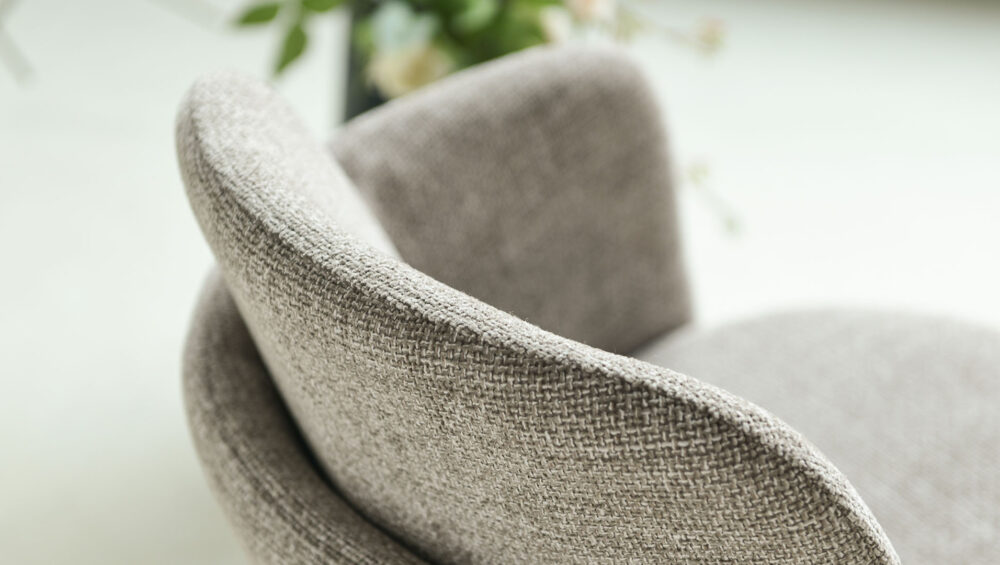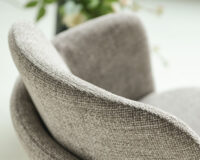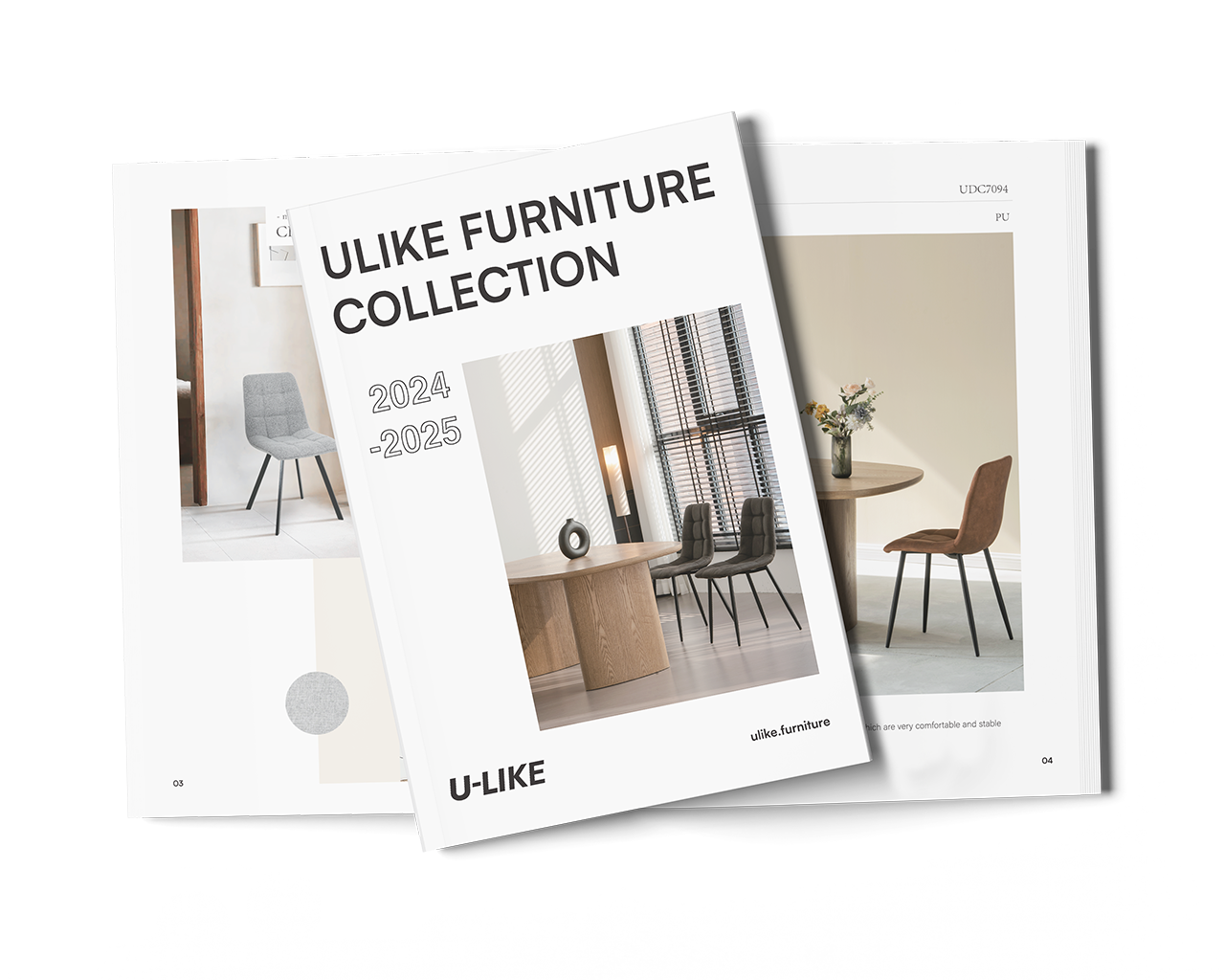Elevating Dining Spaces: The Art of Choosing Elegant Dining Chairs
Dining chairs are more than just a place to sit—they’re a critical component of the dining experience. When it comes to furnishing a dining space, selecting the right dining chairs enhances the aesthetic appeal of a dining space, creating a cohesive look that complements the table and other furnishings that elevate both functionality and aesthetics. The right dining chairs can transform a room, enhance comfort for customers or clients, and complement your business’s branding.
No matter what kind of furniture business you have, understanding the intricacies of dining chair selection is key to meeting customer needs and enhancing your product offerings. However, sourcing OEM and ODM dining chairs can be a complex task, especially when selecting pieces tailored to specific end-user needs—whether for homes, restaurants, or specialized markets. Achieving the perfect balance of style, durability, and comfort often requires a refined selection process, ensuring each chair aligns with the unique demands of your clientele.
This comprehensive guide will walk you through various types of dining chairs, styles, materials, and design considerations to ensure you make an informed choice.
Understanding Different Types of Dining Chairs

Dining chairs come in various designs, each crafted with distinct forms, materials, and purposes. From classic wooden styles to sleek modern metal options, understanding the types available can help in selecting chairs that not only complement an interior but also meet functional needs. For businesses, like restaurants or hotels, it’s essential to consider the durability and comfort of each type, ensuring they align with high-traffic use.
1. Side Chairs
Side chairs are versatile, armless chairs that fit easily around any dining table. Their compact design allows more room, making them ideal for restaurants or cafes with limited space. Side chairs come in numerous styles, from sleek, modern designs to more traditional wooden frames. They are available in materials like wood, metal, and plastic, which allows flexibility depending on the ambiance you want to create.
2. Armchair
Dining armchairs offer added comfort and support with armrests, making them a suitable option for more formal dining areas or luxury settings. While they occupy more space than side chairs, armchairs add a sense of elegance and sophistication to the room. Materials like upholstered fabric and leather are common for dining armchairs, adding a touch of luxury and comfort.
3. Parsons Chairs
Named after the Parsons School of Design, Parsons chairs are simple, streamlined chairs that work well with various decor styles. Typically upholstered, they add comfort while maintaining a refined look, making them suitable for both formal and casual dining areas. Available in numerous fabrics and colors, Parsons chairs can fit seamlessly into a variety of settings, from minimalist to rustic.
4. Windsor Chairs
The Windsor chair is a classic style that originated in England in the 18th century. It’s known for its curved back and spindle design, adding a touch of traditional charm. Windsor chairs are often made of wood, which complements rustic or farmhouse-themed interiors. Despite their vintage appeal, Windsor chairs have also been adapted for contemporary settings, often featuring colorful finishes.
5. Ladder-Back Chairs
Ladder-back chairs are a popular choice for those seeking a rustic or country-style look. Named for their back design that resembles a ladder, these chairs are typically crafted from wood and can be left unfinished for a more authentic feel. Ladder-back chairs provide comfort and stability, making them an excellent option for casual dining spaces.
Dining Chair Styles and Suitability for Different Settings
Dining chair styles vary widely, each offering unique characteristics suited for specific environments. For instance, upholstered chairs provide added comfort, making them ideal for extended dining in upscale restaurants, while minimalist metal or wood chairs are often more suitable for casual or high-traffic settings like cafes. In selecting a style, it’s crucial to match the chair’s aesthetic and durability to its intended use, ensuring that each setting—from fine dining to relaxed eateries—maintains both comfort and visual appeal. This tailored approach allows businesses to align functionality with the ambiance of the dining space.
1. Modern Dining Chairs
Modern dining chairs often feature clean lines, minimalistic designs, and innovative materials. Common materials include metal, plastic, and plywood, providing a sleek and contemporary look. These chairs are perfect for cafes, restaurants, or modern office dining areas, as they convey a sense of sophistication and simplicity. The modern style focuses on functionality without sacrificing style, making it a practical choice for high-traffic settings.
2. Industrial Dining Chairs
Industrial dining chairs are popular in modern urban and loft-style spaces. These chairs often feature metal or distressed wood, riveted or welded frames, and a raw, unfinished look. They are an ideal choice for cafes or restaurants that want to incorporate an edgy, industrial aesthetic. Many industrial chairs also come in stackable or foldable versions, offering practical storage options for flexible seating arrangements. Industrial-style chairs are often paired with metal or reclaimed wood tables to complete the look.
Industrial-style dining chairs are known for their raw, unfinished look, often featuring metal frames, exposed rivets, and distressed wood. Inspired by urban lofts and factory aesthetics, these chairs fit well in industrial-themed cafes and restaurants. The combination of metal and wood in these chairs offers durability, making them ideal for spaces requiring a rugged yet stylish look.
3. Rustic Dining Chairs
Rustic dining chairs emphasize natural materials, warm tones, and a handcrafted look. Typically made from wood with a distressed or unfinished look, these chairs work well in countryside-themed restaurants, farmhouses, or casual dining spaces. The rustic style adds warmth and character, giving customers a cozy, welcoming feel. Ladder-back and Windsor chairs are popular rustic styles that enhance a traditional aesthetic.
4. Traditional Dining Chairs
Traditional dining chairs are often associated with elegance, featuring intricate carvings, plush upholstery, and rich wood finishes. These chairs are ideal for formal dining settings or high-end restaurants looking to create a luxurious experience. The traditional style usually includes armchairs with details like cabriole legs, wingback designs, or ornate woodwork. While these chairs may require more space, they exude a timeless charm that appeals to many.
5. Contemporary Dining Chairs
Contemporary dining chairs are versatile and blend elements from different design styles. Unlike modern styles, which follow specific minimalistic principles, contemporary designs are flexible and often reflect current trends. This adaptability makes them a great choice for businesses wanting to update their dining space without committing to a single style. These chairs often combine materials like metal and fabric, offering both comfort and a modern aesthetic.
6. Mid-Century Modern Dining Chairs
The mid-century modern style has made a strong comeback in recent years. Known for its organic shapes, wooden frames, and tapered legs, this style emphasizes simplicity and function. Mid-century chairs fit well in both casual and upscale settings, offering a retro vibe without feeling outdated. With materials like molded plastic and leather upholstery, mid-century modern chairs can add an artistic touch to any dining space.
Dining Chair Style Guide for Specialized Uses
For businesses that require a unique or specialized dining environment, certain dining chair styles can elevate the space, add character, and even become a talking point for clients or customers. Let’s explore some niche dining chair styles that offer both function and style.
1. Antique and Vintage Dining Chairs
Antique and vintage dining chairs are perfect for creating a classic, elegant atmosphere. Styles like 1920s dining chairs, Chippendale, and Queen Anne chairs bring an old-world charm that is ideal for upscale restaurants, luxury hotels, or dining spaces with a historical theme. These chairs are typically crafted from high-quality wood and may feature intricate carvings, which add sophistication. Identifying antique dining chair styles can enhance the aesthetic, and pairing them with antique dining tables can create a cohesive, timeless look.
2. Upholstered Wingback Dining Chairs
Wingback chairs, traditionally used as armchairs, have made their way into dining spaces for a luxurious look and added comfort. Wingback dining chairs feature high backs and “wings” on either side, creating an enclosed and comfortable seating experience. They are particularly suited to formal dining rooms or high-end restaurants, where comfort and aesthetics are a priority. Upholstered wingback chairs can be customized in various fabrics, adding texture and color to the space.
3. Cantilever Dining Chairs
Cantilever chairs are unique in their design, with a seat suspended on a frame, creating a slight bounce for extra comfort. These chairs are usually made with metal frames and leather or fabric upholstery, making them a popular choice for contemporary dining spaces. Their minimalist and sleek design works well in modern office dining areas or high-end cafes. The cantilevered design provides comfort and flexibility, making it a distinctive choice for a stylish dining environment.
These chairs have a unique design with a seat that “floats” on a metal frame. The cantilever effect provides slight movement, adding comfort. Cantilever dining chairs are popular in modern interiors and bring a stylish flair.
4. Cross-Back and X-Back Dining Chairs
Cross-back or X-back chairs have a distinctive X-shaped design on the backrest, adding visual interest. These chairs are common in rustic and farmhouse-style settings and are usually made from wood with a distressed finish. They add a vintage, laid-back charm to any dining space, making them popular in countryside-themed restaurants or cafes. Cross-back chairs can also be paired with cushions for added comfort and a pop of color.
Custom and specialty dining chairs
In addition to standard styles, some businesses may benefit from custom or specialty dining chairs. These chairs are often tailored to meet specific needs, ensuring that they perfectly complement the space and its purpose.
1. Extra-wide and Extra-sturdy Chair
For businesses that cater to a diverse clientele, such as inclusive dining spaces or hospitality venues, extra-wide and extra-sturdy dining chairs provide comfort and accessibility. These chairs are designed with broader seat widths and reinforced frames to accommodate all guests comfortably. Choosing sturdy materials, such as hardwood or metal, ensures that these chairs will be durable and support a range of body types.
2. Narrow Dining Chairs
In smaller or more intimate dining spaces, narrow dining chairs help maximize seating without crowding the room. These chairs are ideal for bistro-style settings or cafes with limited floor space. Narrow chairs are available in various styles, from contemporary to rustic, allowing businesses to maintain their aesthetic while optimizing the seating arrangement.
3. High-Back Dining Chairs with Arms
High-back dining chairs with arms offer additional support and a formal appearance. They are perfect for luxury dining rooms, fine-dining restaurants, or upscale cafes. These chairs add a sense of grandeur and are typically more comfortable for extended periods, as they provide support for the back, arms, and shoulders. Pairing high-back chairs with a grand dining table can create an elegant and inviting dining atmosphere.
4. Stackable and Folding Dining Chairs
For event venues, banquet halls, or any setting where flexibility is needed, stackable and folding dining chairs provide practical and space-saving solutions. These chairs are easy to store and can be arranged quickly to accommodate different seating needs. Stackable and folding chairs come in various styles and materials, from metal and plastic for casual settings to padded and upholstered versions for a more upscale appearance.
5. Low-Back Chairs
Low-back dining chairs provide a more casual and versatile seating option. Low-back chairs are ideal for contemporary spaces, as they don’t obstruct sightlines, making the room feel open and airy.
Materials and Designs
Selecting the right material for your dining chairs is crucial for durability and aesthetics. Here are some popular options:
1. Wood
Wooden dining chairs bring a natural, timeless appeal to any space. They’re versatile, available in numerous finishes, and fit seamlessly with various interior styles. Hardwood options like oak, walnut, and mahogany are known for durability and are ideal for high-traffic areas.
2. Metal
Metal chairs are commonly used in industrial or contemporary settings due to their sleek look and durability. Materials like steel or iron are often powder-coated to prevent rust, making metal chairs suitable for indoor and outdoor dining spaces. Metal chairs are easy to clean and maintain, making them practical for busy establishments.
3. Upholstered Fabric
For added comfort, many dining chairs feature upholstered seats or backs. Fabric options offer a wide range of colors, textures, and patterns, allowing for customization. However, upholstered chairs require more maintenance, especially in high-use areas, as they can stain or wear over time.
4. Leather
Leather or faux leather dining chairs exude luxury and sophistication, perfect for upscale dining spaces. Leather is durable, easy to clean, and develops a unique patina over time, adding character. Faux leather offers a similar look at a more affordable price and is available in a broader color range.
5. Plastic and Acrylic
Plastic and acrylic chairs are often seen in modern, minimalist settings. They are lightweight, easy to clean, and stackable, making them practical for small spaces or businesses needing flexibility in seating arrangements. Clear acrylic chairs add a contemporary touch without visually cluttering the space.
Selecting Functional and Comfortable Dining Chairs
When choosing dining chairs for a business setting, functionality and comfort are as important as style. Comfortable seating not only enhances the dining experience for customers but also encourages them to stay longer, which can benefit businesses like restaurants, cafes, and lounges. This section explores the essential features to consider for both comfort and durability.
1. Comfort Considerations
Comfort is key, especially for dining chairs that will be used for extended periods. Here are some elements to focus on:
Seat Cushioning
Upholstered dining chairs with plush seating offer better comfort than unpadded seats, which can be uncomfortable for prolonged use. Cushioned seats with high-density foam provide lasting support and are less likely to lose their shape
Ergonomic Back Support
Chairs with curved or contoured backs that follow the natural shape of the spine provide better support. High-back dining chairs offer more substantial support, which can be ideal for upscale or formal dining settings, while low-back chairs might be more suitable for casual environments.
Armrests
Chairs with armrests add a sense of luxury and make sitting more comfortable, especially in high-end dining spaces. However, they require more space, so consider this for smaller settings.
Seat Width and Depth
Wide-seat dining chairs are ideal for ensuring comfort, particularly in commercial settings where guests may differ in body types. Make sure the seat depth is adequate for back support without forcing guests to lean forward.
2. Durability and Maintenance
For high-traffic commercial spaces, durability and ease of maintenance are crucial. Dining chairs should withstand frequent use and be easy to clean. Here’s what to consider:
Material Quality
High-quality materials like hardwood, metal, and leather ensure longevity. While wooden chairs bring warmth, metal frames are sturdier and can withstand heavier use. For outdoor dining spaces, weather-resistant materials like aluminum or treated wood are essential.
Cleaning and Care
Chairs with removable cushions or wipeable surfaces (such as faux leather or vinyl) are easier to maintain. Upholstered chairs in fabrics with stain-resistant treatments are also an excellent choice for busy dining areas.
Reinforced Frames
Look for chairs with reinforced joints or metal frames, as these are less likely to break or loosen over time. Chairs with extra stability features, like nonslip feet, are ideal for spaces where furniture might shift frequently.
Matching Dining Chairs with Tables
Pairing dining chairs with tables is more than just matching materials; it’s about creating a cohesive look that enhances the dining experience. Here are some tips for finding the right match:
Size and Scale
When choosing chairs for a dining table, consider the size and scale of both. A large table paired with small chairs can look unbalanced, while oversized chairs at a small table may feel crowded. Ensure that the chair height complements the table height, with enough legroom for comfort.
Shape Compatibility
The shape of the dining table can impact chair selection. Round tables pair well with armless chairs, as they allow for easier movement and access around the table. Rectangular or square tables, on the other hand, work well with both side chairs and armchairs, depending on the available space.
Style Coordination
The chair and table style should work together to create a unified look. For example, pairing a rustic wooden table with modern metal chairs might create a striking contrast in an industrial-themed space. For a more harmonious look, choose chairs that match the table’s material or finish.
Color and Finish
The color and finish of dining chairs can either match or contrast with the table. Monochromatic color schemes create a sophisticated look, while contrasting colors add visual interest. For instance, pairing a dark wood table with light-colored chairs can highlight both pieces, making them stand out.
Final Considerations and Practical Tips for Choosing Dining Chairs
Choosing the perfect dining chairs for a business requires careful thought about style, comfort, durability, and functionality. The following are essential considerations and tips to help you make the best choice for your specific business needs.
1. Space and Layout Considerations
The physical layout of your dining area significantly impacts the type and number of chairs you can accommodate. Here are a few key factors:
Chair Dimensions and Table Space
Consider the width, depth, and height of the chairs relative to the table. For optimal comfort, ensure there’s at least 12 inches between the seat of the chair and the tabletop. When arranging chairs, leave 24 to 30 inches of space between each seat to allow guests to move comfortably.
Room Shape and Table Shape
Different table shapes complement specific chair arrangements. For example, round tables pair well with armless chairs, while rectangular tables can accommodate a mix of side and armchairs at the head.
Aesthetic Balance
Mixing chair styles (e.g., high-back chairs at the ends and side chairs along the sides) creates a visually dynamic look. Ensure the chair designs complement each other, either through material, color, or shape.
2. Budgeting and Quality
Balancing cost and quality is essential, especially for businesses where dining chairs are a long-term investment. High-quality chairs often require a larger upfront investment but provide durability, comfort, and aesthetics that last.
Quality Over Quantity
Opting for fewer high-quality chairs rather than more low-cost ones may reduce replacement costs and repairs over time. Quality materials like hardwood or high-gauge metal tend to withstand heavy use better than softer woods or lightweight metals
Test Before Buying
If possible, test different chairs to ensure they meet your standards for comfort and durability. Look for details like sturdy joints, smooth finishes, and solid frames
Conclusion
Choosing the ideal dining chairs for your business can transform your space and enhance customer satisfaction. With countless options available, selecting chairs that balance style, comfort, and durability is key to creating a welcoming and memorable dining experience. As an OEM and ODM provider, we specialize in crafting high-quality, custom dining solutions designed to meet the unique needs of every business.







